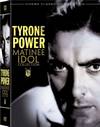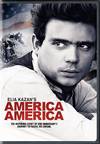





Victor Fleming
Awards | Article | Image Credits | THE WIZARD OF OZ | GONE WITH THE WIND
| Article: |
A Forgotten Maker of the Unforgettableby Michael SragowThe New York Times November 15, 1998, Section 2A; Page 37Michael Sragow edited "Produced and Abandoned: The National Society of Film Critics Write on the Best Films You've Never Seen." In 1938, the director Victor Fleming made a movie about a Kansas farm girl who gets swept into the air and enters a dizzying world of excitement and heartbreak. It was called "Test Pilot," it starred Myrna Loy, Clark Gable and Spencer Tracy, and it was an enormous hit. Later that year, he took over a troubled production about another Kansas farm girl who gets swept into the air and enters a dizzying world of excitement and heartbreak. It was called "The Wizard of Oz," it starred Judy Garland, Ray Bolger and Bert Lahr, and it failed to recoup its costs. Fleming's career is a study in the vagaries of movie history. In the days of the Hollywood "dream factory," he was a towering figure. In his engaging memoir "Studio Affairs," Vincent Sherman recalls Gable's telling him that Mr. Sherman knew more about film than any director except Fleming. Mr. Sherman took it as a compliment. Yet today, critics and festivals pay more attention to Mr. Sherman, whose most famous movie is probably "Old Acquaintance," than they do to Fleming, who directed two of America's best-loved pictures -- "The Wizard of Oz" and "Gone With the Wind" -- for release in a single year: 1939. Fleming's reputation as a tough leader, a savvy filmmaker and Gable's favorite director led David O. Selznick to recruit him to take over "Gone With the Wind," a production even more troubled than "Oz." Fleming won an Oscar for filming most of this prototype of prestige blockbusters. Over the next half-century, "The Wizard of Oz" and "Gone With the Wind" would run neck and neck in stature and popularity. "Oz" was one of the first event movies on network television when it was broadcast in prime time, in 1956. Between 1959 and 1998, "Oz" was shown with unmatched regularity, going from a box-office disappointment to a broadcast cash cow. Last week the fabled musical re-opened on more than 1,900 screens, nine months ahead of its 60th anniversary. It ranked sixth on the notorious American Film Institute list of "the greatest American movies" and fifth in a separate Los Angeles Times readers' poll. ("Gone With the Wind" ranked fourth and first, respectively.) The MGM production team has received most of the credit for "The Wizard of Oz" and Selznick for "Gone With the Wind." Fleming is a forgotten man. Yet the films he directed helped define "the movies" for generations. His celluloid storybook versions of Stevenson's "Treasure Island" (with Wallace Beery and Jackie Cooper) and Kipling's "Captains Courageous" (with Spencer Tracy and Freddie Bartholomew) became childhood favorites not just for those who saw them in theaters in 1934 and 1937, but also for the legions who caught them after school in the 50's, on television slots like the "The Early Show." In the 60's and 70's, college film series became hot tickets whenever they double-billed Fleming's steamy pre-censorship-code classics: the 1932 comic-erotic melodrama "Red Dust," with Gable and Jean Harlow, and the 1933 satire of sex-symbol celebrity, "Bombshell," again with Harlow. Whether directing swashbucklers or farces or horror films, Fleming knew how to make a movie's kinetic impact serve a writer's intentions rather than the other way around. But next to nothing has been written about Fleming. You would have to read a biography of Ingrid Bergman to learn that during the making of Fleming's "Dr. Jekyll and Mr. Hyde" (1941) -- in which she displays a dazzling, un-self-conscious sensuality -- she became infatuated with her director. "He got things out of me that were different from anything I had done before," she said to The London Times in 1971. "What more can an actor want?" Bergman's 1946 performance on Broadway in Maxwell Anderson's "Joan of Lorraine" prompted Fleming to mount a screen version of the story, "Joan of Arc." As partners and lovers, Bergman and Fleming weathered this exhausting, ruinously expensive epic together. Their affair ended with the movie. He died on Jan. 6, 1949, two weeks after its premiere, while on vacation with his wife and daughters. Bergman had photos of him nearby at the time of her death, 33 years later. Fleming helped imbue "Gone With the Wind" with the appeal of a "women's picture" and the gusto of a bareknuckled adventure. After all, Fleming himself was a man's man and a ladies' man. Male stars like Gable and Gary Cooper and directors like Howard Hawks patterned themselves after him. Female stars -- Clara Bow, Lupe Velez and Norma Shearer, as well as Bergman -- fell in love with him. The renowned producer of musicals Arthur Freed, who did uncredited work for "Oz," told the writer John Kobal that Fleming "was a poet, probably one of the great unsung men of this business." To Freed, he was not just a "strange fellow" who "had this feeling": he was "even greater than John Ford, who was one of the masters." Born in Pasadena, Calif., in 1883, Fleming was a race-car driver and mechanic and a Signal Corps photographer who got his big break in the industry working as a cameraman for Douglas Fairbanks Sr. He was one of those native Westerners who based stirring fantasy on real experience. His hugely influential 1929 version of Owen Wister's cowboy romance, "The Virginian," was an early talkie with the visual zest of the immortal silents, a Western milestone comparable to John Ford's "Stagecoach" (1939). It was this movie that turned Gary Cooper into an American icon: as the Virginian he walks softly and carries a big gun. He is not just laconic; he is lyrically laconic. He does not holler or simper or carelessly toss his weight around. What he does is obey the rules of frontier morality, even when they hurt. He lynches his closest friend (Richard Arlen) for cattle rustling and, hours before his wedding, faces the ultimate black-hat villain, Trampas (Walter Huston), in a shootout. From the rugged locations in the High Sierras to the unforced sound effects and confident pacing, the feel and style of the film are what used to be called "virile." Traditional masculine pride demanded that a man take action against threats or insults, serve his own independent morality and play the sexual aggressor. Fleming's top films codified those values and made them irresistibly seductive. Gable reached his peak as a pulse-racing heartthrob in "Red Dust." Playing the super-competent boss of an Indochinese rubber plantation, he mesmerizes an elegant married woman (Mary Astor) and a good-natured prostitute (Harlow). Few films are this funny and frank about committing adultery and covering it up. Gable goes to bed with both women without devastating Astor's decent husband. And he winds up with the woman who is best for him, Harlow. Gable's brusque persona is like Cooper's with the courtliness singed off. Fleming's "Bombshell" demonstrates how much clout he wielded in his heyday. According to an interview with his favorite screenwriter, John Lee Mahin, this delirious burlesque about the "Monarch" studio began as the tragedy of an exploited star. Then Mahin said it struck him as a comedy, and Fleming started reminiscing about the chaotic home life of "the It girl," Clara Bow: she had a dog with the run of the house, "a beautiful Oriental rug with coffee stains," and "her father'd come in drunk." Knowing without being smarmy, Fleming and Mahin added arpeggios of grace notes. Harlow's title character, for example, is just finishing up "Red Dust." In the studio-within-the-film, the Hays Office censors threaten to cut the prostitute's nude bathing scene. In 1934, the Hays Office suggestions for eliminating raciness from the American screen became binding. Fleming answered the call for family entertainment with "Treasure Island" and "Captains Courageous." When the producer Mervyn LeRoy scrapped the early footage of "The Wizard of Oz" and fired the first director, Richard Thorpe, he turned to Fleming because he needed a moviemaker with a child's eye for wonderment. Fleming had settled into marriage; Mahin thought Fleming took on "Oz" because it connected to his close bond with his daughters. Much of the vitality of "Oz" springs from the way Lahr, Bolger and many others turn their roles into vaudeville acts. Fleming's sure touch with these performers should not have been a surprise. He had directed comedy since the silent days. And there had been a vaudevillian strain to "Bombshell," too, which featured Frank Morgan, the Wizard himself, as the bombshell's comical fraud of a father. Fleming's impeccable handling of Judy Garland was not different in kind from the work he did with other child actors or insecure stars like Gable. King Vidor took over the direction of the sepia-toned Kansas scenes when Fleming departed for Tara. But Fleming and Mahin had already left their mark. According to Aljean Harmetz's "The Making of the Wizard of Oz," the pre-Fleming script commenced with static farmland shots and a blase Dorothy "riding a pony, talking to a scarecrow, and grinning." In Mahin's version, we see Dorothy in turmoil from the get-go, anguished over the prospect of losing her dog, Toto, to the vile Miss Gulch and unable to interrupt Aunt Em and Uncle Henry as they deal with a malfunctioning incubator. Her urge to escape is immediately understandable. Whether on the high seas of "Captains Courageous" or in the high altitudes of "Test Pilot," Fleming made sure to root adventure in sturdy emotions -- like Garland's ardent, innocent yearning for happiness, then home, in "Oz." His biggest stars long outlived and overshadowed him. Yet Fleming's reputation remains high among filmmakers as varied as James Cameron and Philip Kaufman (an admirer of "Red Dust"). In 1989, Steven Spielberg, a devout fan of Fleming's, remade Fleming's World War II tear-jerker, "A Guy Named Joe" (1943), as "Always." And no director had a year like Fleming's 1939 until Spielberg made "Jurassic Park" and "Schindler's List" in 1993. Fleming is still anonymous to the general moviegoing public. Perhaps that is because his contributions to American popular culture are so profound as to be intangible. He conjured a sense of childhood that included risk and wildness. And in bold, textured images, he conveyed a notion of adulthood that was adventurous and sexually up-front but rarely flighty or irresponsible. "Of all the men I've known," Clara Bow once said, "there was a man." © 1998 The New York Times Company |
|
Return to the Victor Fleming main page. |
| Current Contest Prize: |
|---|
| Now in Print! |
|---|
| Now on DVD! |
|---|
Buy Videos & DVDs |
|
Buy Movie Posters |
|
Buy Movie Posters |
|
Classic
Movie Merchandise |
|
![]() Printer-friendly version.
Printer-friendly version.
![]() Return
to the top.
Return
to the top.
Last updated:
March 10, 2011.
Reel Classics is a registered trademark of Reel Classics, L.L.C.
© 1997-2011 Reel Classics, L.L.C. All rights reserved. No
copyright is claimed on non-original or licensed material.
Terms of
Use.










